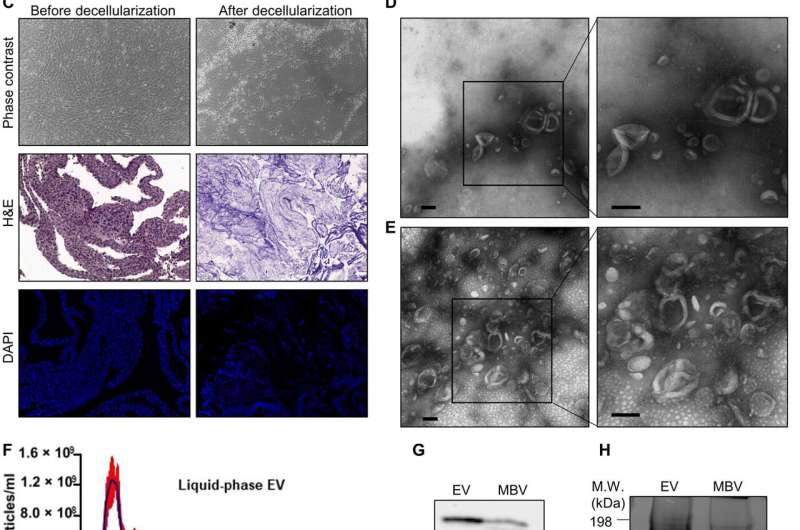Researchers study a novel type of extracellular vesicles

Researchers from Sechenov University and the University of Pittsburgh compared the properties of two groups of extracellular vesicles. Either present in a liquid phase or attached to the fibres of the extracellular matrix, these vesicles facilitate metabolism and cell-cell communication. A better understanding of their structure, production and movement can help create new bioengineered materials and repair damaged tissues more quickly. Findings are published in Science Advances.
The extracellular matrix (ECM) fills the space within tissues, creating a scaffold for separate cells and a dynamic environment for cells, organelles and molecules to move in. Varying in composition and consistency from tissue to tissue, it performs several key functions such as mechanical support of tissues, division of different types of cells and transportation of substances, including signalling molecules.
Tissue engineering utilises materials derived from the ECM, making it critical to preserve its structure and functions. Extracellular vesicles (EVs) are tiny vesicles released by cells and involved in the transfer of part of their content, such as proteins, lipids, enzymes and microRNAs. Several years ago, researchers discovered that some of the vesicles are attached to the ECM fibres, terming them matrix-bound vesicles (MBVs). Their composition and membrane structure have not been studied so far.
The authors decided to compare the structure and properties of liquid-phase EVs and MBVs. In order to rule out the differences linked to their provenance from different tissues, the researchers used a cell culture environment to control the cell type and medium.
Both groups showed a similar size of no more than 200 nanometres (typical of most of the extracellular vesicles in general), but a different composition of proteins, lipids and microRNAs they transport. MBVs, just like parent cells, contained a much greater share of cardiolipin, which is almost exclusively found in mitochondrial membranes—an indication that mitochondria and MBVs can have a common origin. Liquid-phase EVs, meanwhile, revealed a higher level of lipoxin, which inhibits inflammation and stimulates tissue regeneration (through the activation of immune cells). The study also highlighted differences in the contents of vesicles obtained from different tissues, although the set of lipids and microRNAs in MBVs is rather consistent.
The findings suggest that the future behaviour of the vesicles (whether they will move in a liquid medium or stay attached to the matrix) is determined during their production stage. The fact that MBVs are embedded within a dense network of fibres shows that cells are most likely to release them when tissues are built or the damaged matrix is repaired. Due to consistency of their lipids and microRNAs, MBVs can be used for both diagnostic and therapeutic purposes as well as the manufacture of new biomaterials.
More information: George S. Hussey et al, Lipidomics and RNA sequencing reveal a novel subpopulation of nanovesicle within extracellular matrix biomaterials, Science Advances (2020). DOI: 10.1126/sciadv.aay4361
Journal information: Science Advances
Provided by Sechenov University


















